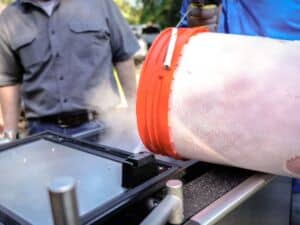
How Does It Work?
Pioneering the use of cutting-edge technology, General Abrasives provides dry ice blasting as an alternative to traditional industrial cleaning methods. From the oil and gas industry to heavy equipment and foodservice cleaning applications, as well as fire or historical restoration, marine applications, and automotive restoration, dry ice blasting revolutionizes the cleaning process across various industries. General Abrasives stands at the forefront of this technological advancement, employing Cold Jet equipment in its blast cleaning service to deliver unparalleled cleaning solutions.
What is Dry Ice?
Dry ice is created by compressing and cooling gaseous carbon dioxide until it liquefies. Under reduced pressure, the liquid CO2 expands, rapidly cooling and solidifying into a snow-like substance.
This solid CO2 is then compressed into pellet or block form, depending on the intended application. Pellets are typically small, ranging from rice-sized to larger pieces, facilitating ease of handling and effective blasting.
Understanding Dry Ice Blasting
So how does dry ice blasting work? Dry ice blasting, a non-abrasive cleaning method, involves propelling dry ice pellets at high speeds using compressed air to eliminate contaminants without causing damage to the underlying surface. But what makes this technique stand out?
At its core, dry ice cleaning harnesses the power of sublimation – the transformation of solid CO2 into gas – upon impact with the surface. This rapid phase change creates mini-explosions that dislodge dirt, grime, and unwanted substances, leaving a pristine surface behind.
- Propelling Dry Ice: These dry ice pellets are loaded into the blasting equipment’s hopper. Compressed air, accelerated to high velocities, propels the pellets through a nozzle toward the targeted surface.
- Impact and Sublimation: Upon impact, the pellets rapidly transfer their kinetic energy to the surface. The extreme temperature difference between the -78.5°C (-109.3°F) dry ice pellets and the warmer surface causes sublimation. The pellets instantaneously transition from a solid to a gaseous state without becoming a liquid, expanding in volume.
- Micro-explosions: The rapid expansion of the CO2 gas creates micro-explosions between the surface contaminants and the substrate. This sudden expansion dislodges and lifts away dirt, grime, coatings, or other unwanted materials, effectively cleaning the surface.
- Residue Removal: The gaseous CO2, being lighter than air, dissipates into the atmosphere, leaving no residual waste or moisture on the cleaned surface. The only remnants are the removed contaminants, which can be easily collected.
The Technology Behind Cold Jet Equipment
General Abrasives utilizes Cold Jet’s cutting-edge equipment, known for its precision and efficiency in various cleaning applications. The Cold Jet technology allows for precise control of the dry ice pellet size and velocity, ensuring tailored cleaning suitable for different surfaces and contaminants.
Versatility in Cleaning Applications
Dry ice showcases its versatility at cleaning equipment across many industries:
– Manufacturing: From removing paint and coatings on machinery to degreasing equipment, dry ice blasting offers a gentle yet effective solution without leaving behind secondary waste.
– Food Processing: Ensuring sanitation and compliance, dry ice blasting eliminates contaminants in sensitive environments without using water or chemicals, thus maintaining the integrity of the food production process.
– Fire Restoration: Effectively removes soot and smoke residues without further damaging affected surfaces, expediting the restoration process after fire incidents.
– Automotive: Removes grease, paint, and contaminants from machinery, engine components, and assembly line equipment without causing damage or leaving residue.
– Historical Restoration: Dry ice blasting delicately restores historical artifacts, statues, and architectural elements, preserving intricate details without harming the original surfaces.
– Oil and Gas: Effectively cleaning equipment, pipelines, and storage tanks, dry ice blasting eliminates built-up oil, corrosion, and residues while maintaining the integrity of the machinery.
– Marine: Cleaning ship hulls, dry ice blasting can be used to remove barnacles, rust, and marine growth without damaging the underlying surfaces, ensuring optimal vessel performance and longevity.
Advantages Over Conventional Blasting Methods
Dry ice blasting and the use of abrasives present several advantages over traditional methods like water or sand blasting:
- Eco-Friendly: Dry ice blast cleaning involves no secondary waste as the CO2 pellets sublimate upon contact, leaving behind only the removed contaminants. It’s non-toxic and doesn’t produce harmful chemicals, making it environmentally friendly.
- Gentle Yet Effective: Unlike sand blasting that can cause surface abrasions or water blasting that might create residual moisture, dry ice blasting is gentle and non-abrasive, preserving the integrity of the underlying surface.
- Reduced Downtime: The absence of drying time, as in water blasting, and the minimal cleanup required after dry ice blasting significantly reduce downtime, allowing for faster turnaround.
- Versatility: The ability to seamlessly switch between dry ice blasting and abrasive media offers a versatile cleaning solution suitable for a wide range of surfaces and contaminants.
Dry ice blasting not only elevates efficiency in the cleaning process, but also offers superior cleaning solutions that set a new standard in the industry. By eliminating abrasive media, reducing cleaning time and labor costs significantly, and ensuring a non-abrasive, chemical-free process, dry ice emerges as the forefront choice across industries. With over 30 years of cumulative experience in the industry, General Abrasives provides a level of expertise that is unparalleled. Our commitment to innovation and excellence is evident in every project we undertake.




